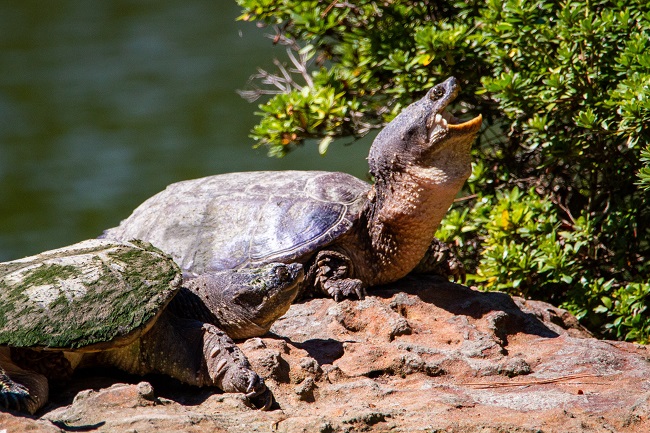
The snapping turtle is a large freshwater turtle that is native to North America. It is known for its powerful jaws and aggressive behavior and is one of the largest freshwater turtles in North America.
Snapping turtles have a rough, spiked shell that can vary in color from gray to brown to black. They have a long tail, and their head is large and powerful, with a sharp, hooked beak that they use to capture and consume their prey. Snapping turtles can grow up to two feet in length and can weigh over 50 pounds. Click here to learn how to determine the age of a snapping turtle.
Snapping turtles are found in a variety of aquatic habitats, including rivers, lakes, and swamps. They are opportunistic feeders and will eat almost anything they can catch, including fish, insects, amphibians, and small mammals.
While snapping turtles are generally shy and will try to avoid human contact, they can be aggressive if they feel threatened or cornered. They have been known to bite when provoked, and their jaws are strong enough to break fingers or toes.
Despite their intimidating reputation, snapping turtles play an important role in freshwater ecosystems. They help control populations of prey species and serve as a food source for predators such as birds of prey and larger fish.
Snapping turtles have been around for a very long time. Fossils of snapping turtles have been found that date back to the Late Cretaceous period, which ended around 66 million years ago.
Native American tribes in North America have long used snapping turtles as a food source. Some tribes also used the shells of snapping turtles for various purposes, such as making rattles or bowls.
European explorers who arrived in North America in the 16th and 17th centuries encountered snapping turtles for the first time. They were fascinated by the large, aggressive turtles and began hunting them for food and sport. In the 18th and 19th centuries, snapping turtles were considered a delicacy and were heavily hunted. Their meat was used in soups, stews, and other dishes, and their shells were used for various decorative and practical purposes.
By the early 20th century, snapping turtle populations had declined significantly due to overhunting and habitat loss. Some states began implementing regulations to protect snapping turtles, and many people began keeping them as pets rather than hunting them.
Today, snapping turtles are still found throughout much of North America, although their populations have not fully recovered from the effects of hunting and habitat loss. They are still considered a valuable food source in some regions but are also widely appreciated for their unique appearance and behavior.
8 Fun Facts About Snapping Turtles
Snapping turtles are one of the largest freshwater turtles in North America. They can grow up to two feet in length and weigh over 50 pounds.
Snapping turtles are opportunistic feeders and will eat almost anything they can catch, including fish, insects, amphibians, and small mammals. They are known to be particularly fond of carrion and have been observed scavenging on dead animals.
Snapping turtles are named for their powerful jaws, which can snap shut with incredible force. Their jaws can deliver a painful bite, so it’s important to be cautious around them.
Snapping turtles have a reputation for being aggressive, but they are generally shy and will try to avoid human contact. If you encounter a snapping turtle in the wild, it’s best to observe it from a safe distance and avoid provoking it.
Female snapping turtles are known to lay their eggs in a variety of locations, including sandy beaches, gravel bars, and even roadside ditches. The eggs hatch after a few months, and the baby turtles make their way to the water.
Snapping turtles have a unique way of respiring. They can extract oxygen from the water using specialized structures in their cloaca (the opening used for mating and excretion), which allows them to stay submerged for long periods of time.
Snapping turtles have a long lifespan and can live up to 50 years in the wild. They are also capable of surviving in a wide range of aquatic habitats, from polluted urban streams to pristine wilderness lakes.
In some cultures, snapping turtles are considered a delicacy and are used in traditional dishes. In the United States, snapping turtles are still hunted for their meat in some regions, although regulations have been put in place to limit harvest and protect populations.
Related Articles & Free Email Newsletter Sign Up
6 Fun Facts About Red Eared Slider Turtles
Everything You Need to Know About Turtles


Comment here